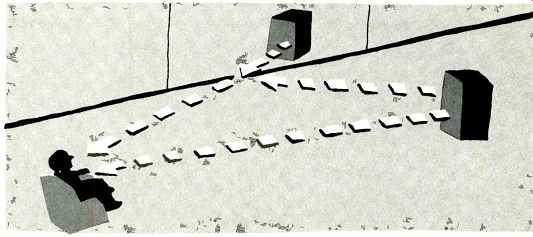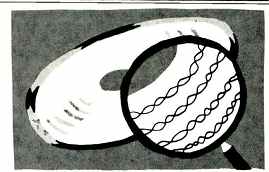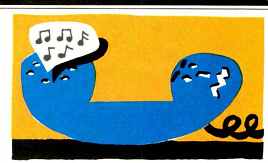LEVERAGED TRYOUT

Mirror, Mirror
Bang & Olufsen of Denmark, KEF Electronics of England, and the Acoustics Laboratory of the Danish Technical University are working jointly on a psychoacoustics research project whose aim is twofold: To determine the effects of room reflections on reproduced sound, and to discover how to minimize those effects in loudspeakers. The project, called Archimedes, is part of the Eureka research program funded by 19 European countries and the European Economic Community.
How do you study room effects without limiting yourself to the effects of a particular room? One way would be to build a lot of rooms; another would be to keep altering one room's dimensions and materials. However, those approaches would cost far more than Archimedes' $3 million budget.
Instead, the project will be doing it with mirrors-or, rather, taking advantage of the fact that a room's surfaces reflect sound very much the way mirrors reflect light. Speaker images reflected from a wall are sonically equivalent to duplicate speakers just behind that wall. So the Archimedes approach will be to render the wall acoustically transparent and put a real duplicate speaker just where its sonic image would be if the wall were solid. The "room" will have walls, floor, and ceiling of cloth and be erected in the Technical University's anechoic chamber, one of the world's largest (40 x 33 x 27 feet). The "image" speakers will be positioned outside the cloth walls in locations determined by the angles from which real reflections would come.
The signals going to each image speaker will be digitally filtered to simulate the absorptive effects of particular room surface materials and the frequency effects of off-axis reflections. Where necessary, attenuation and delay will be used to simulate greater reflective distances.
Each speaker will be individually controllable, allowing the study of individual reflections.
A speaker in a room has many images: Primary (reflections of the direct sound from the speaker itself), secondary (reflections of reflections), tertiary (reflections of secondary reflections), and so on. But only the reflections reaching the listener in the first 1/30 S-the ones travelling about 38 feet or less-affect tone quality and imaging.
Thirty-two speakers are needed for the project. All of them (including the primary speaker) must be identical, with wide bandwidth, linear frequency response, and known directivity. They must also be small enough to fit wherever needed and easy to aim at any angle. To meet these requirements, KEF has built a set of small spherical sound sources using 5-inch coaxial drive units.
The Archimedes project is expected to take three years.
Tempest in a Time-Pot

Stereo sound requires two channels, but Compact Discs have just one data track. Therefore, left- and right-channel signals on CDs are interleaved, with 11.34LS bursts of left-channel data alternating with equal right-channel bursts. Some CD player manufacturers take advantage of this situation to save costs, using one D/A converter whose output is switched between the left and right channels at that same rate. As a result, there is a performance trade off: The right channel will lag 11.3 µS behind the left. To prevent this, some players have separate D/A converters for each channel; still others have a single D/A converter but add sample-and-hold circuits to delay the left signal until the right-channel signal can catch up. Some manufacturers point out that even this small delay is enough to cause an interchannel phase difference of 8° at 2 kHz and 81° at 20 kHz.
But does it make a difference in the home? The speed of sound is about 1,127 feet per second; a time delay of 11.3 µS is therefore equivalent to having the right speaker 0.15 inch farther from you than the left one.
In actual listening, the differences in distance will be greater than this.
Live Music in the Lab
Live music and Acoustic Research go back a long way together. In the '60s, they ran live-versus-recorded demonstrations to show how hard it was to distinguish live from properly prepared recorded sound. The results were somewhat predictable (most listeners had trouble telling the live from the recorded sound even when Edison used the technique to demonstrate his cylinder recordings), but still impressive.
Now, AR is using live music for a slightly different purpose. Musicians from Boston's Berklee College of Music are coming to play at the AR labs, so the company's engineers can hear how live music sounds in the spaces where they normally hear recorded music, and so they can measure various aspects of the sound.
Hazard on Hold

If your work involves a lot of telephoning, you probably spend a lot of your time on hold. In theory, a little music in the background would be a pleasant way to show a caller that he or she hadn't been disconnected; in practice, I find it a mixed blessing.
It all depends on what is playing.
Easy-listening wallpaper music, which I otherwise dislike, is fine. But radio announcements are distracting (especially Sunbelt weather reports during our Northern winters), and rock is jarring if you're trying to concentrate on something else.
Classical music always starts and ends in mid-phrase. That's frustrating, but I just found a frustration even worse. The other day, a music-on-hold system played a few bars of a tantalizingly familiar symphony which I just couldn't place. The party I was calling didn't hear it since he wasn't on hold, so he couldn't be of help.
Meanwhile, it's been driving me bats:
"Da, da, dee-da-dah; da, da, dee-da dah ..." To quote Charlie Brown.
"Aaaaaargh!"
Cooking with Cables
The other day, while poaching a bluefish in red wine, it struck me that adding bay leaves and fennel seeds would make it tastier. It did.
Like cooking, engineering relies on the art of informed intuition, but with more emphasis on information.
An engineer's experiments tend to be on' less of an ad hoc basis than a cook's. The more you know, the more you can predict, and the less time you have to spend "tasting" each circuit's operation to see if it needs spicing up.
When not enough is known about how things perform or what electrical parameters affect performance, engineers gnaw their knuckles in frustration. "I can design an amplifier," an engineer told me recently, "that sounds perfect-until I change the speakers or cables. Then I hear a difference. But the amplifier still measures the same." We'd expect the sound to change when the speakers do. But as to the cables, there are three possibilities.
We can't entirely ignore the possibility that the engineer is fooling himself about what he hears. Human perceptions, while sometimes more sensitive than those of test instruments, are too often less reliable. Those perceptions are influenced by expectations about what will be perceived; people who expect to hear differences between cables sometimes hear dramatic ones, while people who expect the opposite usually hear none.
It could also be that the signal the amplifier delivers into the cable isn't changing but that the cable somehow alters it en route to the speakers. The engineer would then hear a difference from the speaker, at the cable's far end. However, he would probably have measured the amplifier's performance by hooking his test leads to the amp's output terminals, where the signal had not yet gone through the speaker cable. Therefore, his measurements would have missed any alterations that the cable imposed.
Then, there's the third possibility.
Assuming that the cables did affect the sound, and that my engineer friend was measuring at the cables' output, his problem may have been not knowing which measurements would explain the cables' sonic effect.
Without this knowledge and the information on amplifier/cable/speaker interactions it would yield, he may still be able to build the amp he wants by trial and error-but he cannot engineer one.
The situation is still at the cooking stage, somewhere between guessing what bay leaf would add to the taste and pondering the effects of ground rhino horn on the diner's longevity.
Audio designers can cope with the immeasurable in other ways. But if they can't measure it, they can't engineer it.
Room for ROM
Played through a sound system, non-audio digital data sounds weird at best, and usually downright nasty.
So what would you hear if you inadvertently tried to play a CD-ROM disc through your stereo system? Depending on your player's vintage, you might hear chirpy (and potentially speaker-damaging) noises, but it's more likely that you would hear nothing at all. The "red book" CD Standard suggests (but does not mandate) that CD players mute their analog outputs when playing non-audio discs. According to an article by Barry Fox in the British magazine Which Compact Disc?, early players did not have the muting feature, but manufacturers are increasingly incorporating it. Players can't mute their digital outputs; if they did, the data on CD-ROM and similar non-audio discs would have no way to get out. Therefore, amplifiers with digital inputs will need to incorporate the muting feature too.
Critical Ages

Certain birthdays seem to trigger critical awareness of one's age. For most adults, birthdays that end in zero do it. For others, the shock of awareness comes at birthdays that end in five, when the next big-zero birthday looms on the horizon.
To audiophiles, however, there are only four critical ages. At 33 1/3, you are, at last, long-playing. At 45, you've reached extended play. And by 78, you're a collector's item. But the first of these four ages is less obvious, because it comes before many of us know we're audiophiles yet. It comes at 16 2/3, when we finally have some money to buy records and perhaps even our own stereo. Hand anyone that age a telephone, and he or she becomes a talking book.
(adapted from Audio magazine, Jan. 1988)
= = = =